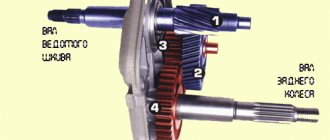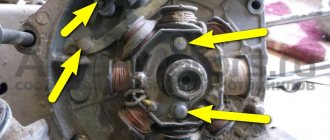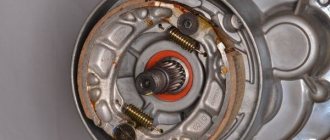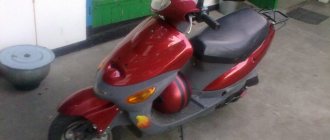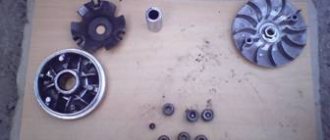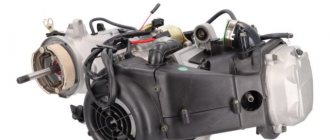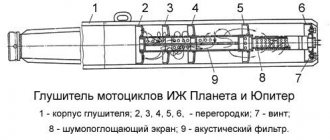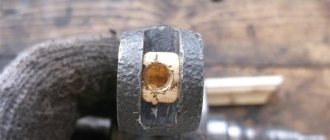Malfunction of the vacuum tap on the scooter
Any equipment, be it a Chinese or Japanese scooter, can malfunction.
And many owners are not able to immediately recognize the cause of the breakdown. Why does the scooter stall and is difficult to start? Often the cause is a very minor problem, such as a malfunction of the vacuum tap. After all, equipment does not tolerate low-quality, dirty or diluted gasoline. Therefore, after a certain time, the scooter begins to stall and cannot be started. Causes of vacuum valve malfunction
Such a seemingly simple problem can actually cause a lot of trouble for the scooter owner. After all, if you do not fix the problem in time, you can have serious consequences. For example, fuel cannot pass to the carburetor because the membrane is stuck along the way. It does not allow gasoline to pass through and of course does not open. Or another common problem - when you turn off the engine, the tap does not close. You can drive with an open tap, but it is better to replace it in time, because sooner or later you will notice a puddle of gasoline under the scooter, as the carburetor shut-off needle will begin to let it through. Therefore, it is better to replace it with a new one.
How to check the serviceability of a vacuum tap
If you doubt the reason for the breakdown of the scooter, you can immediately check the serviceability of the faucet. This is done quite simply: you need to disconnect the gasoline supply pipe and the vacuum tube from the carburetor, place a container and observe - if the tap is working properly, gasoline will not flow from it. Next, you need to draw air from the tube with your mouth, and if gasoline flows into the substituted container from the gasoline supply tube, then everything is in order. If not, you need to change the faucet, since it cannot be repaired, because the body is rolled.
You can buy a vacuum faucet of good quality and at an affordable price on the website begemoto.com.
Consequences of a malfunctioning vacuum valve
The vacuum tap plays an important role in the operation of scooters. And they can lead to complex consequences. It is necessary to pay attention to the fact that if the valve malfunction is not corrected in time, the tire may suffer, because it will become limp from constant contact with fuel. There is also a high risk of fire because there are electrical wires nearby. Therefore, the problem cannot be neglected; it must be eliminated urgently.
Another cause of scooter malfunction may be “hibernation”. It stood in the garage for a long time, the membrane stuck and could not come off, which prevents fuel from passing through. Motorcycle repairs must be carried out on time, so as not to regret later that you will have to invest a lot more money and time.
Any equipment requires constant care and timely repairs. And Chinese and Japanese scooters especially need preventative maintenance and replacement of parts that have worn out or have some kind of malfunction. The main thing is not to ignore signals from technology that a problem has occurred, but to immediately look for it and fix it.
Source
What indicates the fuel pump is not working properly?
If the pump is faulty, this will primarily affect the pressure in the fuel supply system to the engine.
If the pressure is too low, the optimal composition of the air-fuel mixture in the combustion chambers will not be ensured, which means problems will arise in the operation of the engine. External manifestations may be different.
·
- The sound of the engine may be slightly different from usual, especially during warm-up. This symptom is characteristic of the early stage of gas pump disease.
- Noticeable loss of power. At first it affects mainly at high speeds and when driving on an uphill slope. But as the condition of the pump deteriorates, twitching and periodic decelerations may also appear in normal modes on flat sections of the road.
- Troubling and floating speed are signs of a further deterioration of the situation.
- Increased noise or a loud hum coming from the fuel tank indicates the need for urgent attention. Either the pump itself is on its last legs, or it cannot cope with the load due to contamination in the system. It is possible that simply cleaning the coarse filtration mesh will save the fuel pump from death. The problem can also be caused by the fuel filter that performs fine cleaning if it is defective or has not been changed for a long time.
- Startup problems. Things are really bad if even a warm engine has difficulty starting. The need to crank the starter for a long time means that the pump cannot create sufficient pressure in the system to start the engine.
- The engine stalls when you press the gas pedal. As they say, “we have arrived”...
- The absence of the usual sound from the gas tank indicates that the fuel pump is not working. Before putting an end to the pump, you need to check the starting relay, fuse, integrity of the wires and reliability of the contacts in the connector.
It must be borne in mind that some of the listed symptoms may indicate not only the fuel pump, but also a number of other parts - mass air flow sensor, throttle position sensor, throttle valve actuator, idle speed control, clogged air filter, unadjusted valve clearances.
If there are doubts about the serviceability of the pump, it is worth carrying out additional diagnostics, in particular, measuring the pressure in the system.
Vacuum valve on scooter repair
by k_petrovich » Jun 08, 2011, 10:04 am
Re: vacuum fuel tap
by Korider » Jun 08, 2011 10:36 am
Re: vacuum fuel tap
Mars » June 08, 2011, 10:50
Re: vacuum fuel tap
by k_petrovich » Jun 08, 2011, 02:37 pm
Re: vacuum fuel tap
by toofat » Jun 08, 2011 3:05 pm
200 grams per week (cold garage), carefully removed the hose with the filter and put it first into a jar and then into a canister. That's how I spent the winter. I would have already changed it, but I can’t get around to it. In the summer it doesn’t seem to “shrink” and doesn’t flow so noticeably. I attributed it to the Korean climate. So, I don’t know. maybe I was unlucky, but if possible, I would remove it from there
Re: vacuum fuel tap
by k_petrovich » Jun 08, 2011, 03:43 pm
Adjusting the throttle shut-off needle
My Honda Tact AF-31 scooter was distinguished by its exquisite gluttony. Without any twinge of conscience, he could burn up to 8-10 liters of gasoline per hundred kilometers. This is absolutely insane consumption for a 6 hp scooter, because the same consumption for my 175 hp car. Every now and then I drove the canister to the gas station.
No matter what I did, I changed the spark plug, adjusted the carburetor, but even after replacing the cylinder-piston group, nothing changed. The spark plug is wet, the scooter continues to empty the gas tank with an enviable appetite. Until one fine moment I thought that I needed to check and adjust the position of the throttle shut-off needle.
The whole procedure is extremely simple, you don’t even need to disassemble anything.
Unscrew the cover attaching to the carburetor.
Having compressed the spring, we remove the throttle cable from the throttle, the W-shaped needle holder, and here it is - the locking needle. There is a lock on the needle, with which you can adjust the position of the needle, and marks on the needle itself.
If the scooter does not have enough fuel (the spark plug looks light, there is no traction, the maximum speed is low), fuel must be added. To do this, the needle needs to be raised, that is, the lock should be lowered by 1 division. If the scooter consumes an excessive amount of fuel, the spark plug is covered with black soot or is wet, then the amount of fuel supplied must be reduced by lowering the needle - that is, the lock must be raised by one notch.
In my case, with an excessive appetite, I moved the lock 1 notch up, while lowering the needle.
It’s hard to believe, but gasoline consumption after such a simple action dropped by about 2-3 times. In this case, neither traction nor maximum speed were affected. It turns out that before this procedure most of the fuel simply flew into the exhaust pipe.
Please note: This article and the images in it are subject to copyright. Partial or complete reproduction on other resources without permission is prohibited
Malfunction of the vacuum tap on the scooter
Any equipment, be it a Chinese or Japanese scooter, can malfunction. And many owners are not able to immediately recognize the cause of the breakdown. Why does the scooter stall and is difficult to start? Often the cause is a very minor problem, such as a malfunction of the vacuum tap. After all, equipment does not tolerate low-quality, dirty or diluted gasoline. Therefore, after a certain time, the scooter begins to stall and cannot be started.
Causes of vacuum valve malfunction
Such a seemingly simple problem can actually cause a lot of trouble for the scooter owner. After all, if you do not fix the problem in time, you can have serious consequences. For example, fuel cannot pass to the carburetor because the membrane is stuck along the way. It does not allow gasoline to pass through and of course does not open. Or another common problem - when you turn off the engine, the tap does not close. You can drive with an open tap, but it is better to replace it in time, because sooner or later you will notice a puddle of gasoline under the scooter, as the carburetor shut-off needle will begin to let it through. Therefore, it is better to replace it with a new one.
How to check the serviceability of a vacuum tap
If you doubt the reason for the breakdown of the scooter, you can immediately check the serviceability of the faucet. This is done quite simply: you need to disconnect the gasoline supply pipe and the vacuum tube from the carburetor, place a container and observe - if the tap is working properly, gasoline will not flow from it. Next, you need to draw air from the tube with your mouth, and if gasoline flows into the substituted container from the gasoline supply tube, then everything is in order. If not, you need to change the faucet, since it cannot be repaired, because the body is rolled.
You can buy a vacuum faucet of good quality and at an affordable price on the website begemoto.com.
Consequences of a malfunctioning vacuum valve
The vacuum tap plays an important role in the operation of scooters. And they can lead to complex consequences. It is necessary to pay attention to the fact that if the valve malfunction is not corrected in time, the tire may suffer, because it will become limp from constant contact with fuel. There is also a high risk of fire because there are electrical wires nearby. Therefore, the problem cannot be neglected; it must be eliminated urgently.
Gasoline supply problems - common symptoms
Malfunctions of the fuel supply system are conventionally divided into 2 categories:
- The combustible mixture is not supplied to the cylinders at all.
- Gasoline is supplied intermittently or under insufficient pressure.
In the first case, the engine does not start and does not engage the starter during rotation, that is, it does not show signs of life. In such a situation, it is always easier to determine the cause of the breakdown.
When insufficient fuel enters the cylinders, the following symptoms appear:
- starting the power unit “from cold” is very difficult, the engine seizes and “sneezes”, it starts in 3–10 attempts;
- idling is unstable, the engine “troubles”;
- dynamic acceleration becomes impossible - a sharp opening of the throttle causes a long dip and deceleration;
- when the driver releases the accelerator pedal, the engine often stalls;
- The car has difficulty climbing hills and accelerates slowly when fully loaded.
The cause of the above phenomena may be a malfunction of the fuel pump or other elements of the system, and the primary symptoms are almost the same. To carry out an accurate diagnosis, you need to understand how the car's power system works.
How to check the fuel tap of a scooter?
In a scooter, the fuel tap is a fairly simple device that provides the required gasoline supply. This mandatory part of the power system will prevent fuel from entering the carburetor if the engine stops.
At the same time, the fuel valve is designed to perform very important tasks aimed at increasing driver comfort. First of all, it ensures the passive safety of the entire vehicle as a whole.
Design features of the fuel valve
The principle of operation of the fuel tap of a scooter is similar to the operation of the simplest locking devices. The membrane located inside the housing, thanks to the force of the return spring, is pressed against the fuel channel and blocks it.
When the engine is running, a vacuum is formed in the intake manifold, which passes to the membrane through a rubber tube. Under the influence of vacuum, the membrane, compressing the return spring, moves back and opens the fuel channel. Gasoline begins to flow freely into the carburetor through a special fuel line.
If the engine stops running, the process occurs in the reverse order. Due to the drop in vacuum in the intake manifold, only the return spring acts on the membrane. The partition is pressed tightly against the fuel channel and shuts off the fuel supply. Gasoline does not enter the carburetor.
Thus, three tubes fit to the fuel tap:
- — one hose is designed to supply fuel from the tank;
- — another tube leads to the carburetor;
- — the third hose (air) serves to transmit vacuum from the intake manifold under the membrane.
The fuel valve is mounted directly on the scooter frame and is covered by the side fairing.
Checking the fuel tap
The simplicity of the crane design significantly increases its reliability. However, you need to remember that the fuel taps of the scooter cannot be repaired. This is due to the integrity of the product body, which cannot be disassembled.
To check the functionality of the faucet, you need to disconnect the hose from the carburetor and place it in any container that is at hand. Unscrew the air tube from the engine through which vacuum should be supplied. You can simply draw in air through it, and gasoline should begin to flow out of the fuel hose.
If fuel does not flow from the carburetor hose, it means the valve is clogged or faulty. It is imperative to clean the fuel filter installed on the tap. It is not recommended to blow the product with a compressor or pump; this will not give an effective result and will only increase the likelihood of serious damage to the membrane.
Cooling system
All Nexus scooters are equipped with a forced air cooling system. It is needed to prevent jamming and damage to parts due to overheating, which causes excessive expansion of the piston, as well as disruption of lubrication conditions. Since the motor of all scooters is covered with a casing and is located under the seat in the rear, the flow of oncoming air cannot effectively cool it. Therefore, a fan impeller is used, mounted on the right side of the engine on the generator rotor. This centrifugal fan forces air under a casing that covers the outside of the cylinder and cylinder head.
Cooling system details:
- fan impeller;
- casings
How to clean the vacuum tap on a scooter?
Let's figure out how to clean the vacuum tap on a scooter. I would like to immediately reassure you that this process is not complicated, it is more difficult to get to it. On some scooters it is necessary to remove a lot of trim. For example, for the Yamaha axsis I had to remove the seat and the entire upper trim. Here you will have to work hard, if you don’t want these worries, then contact the service center, and if you want to dig around yourself, then read on.
After we removed the lining and got to the vacuum tap. It is necessary to drain the gasoline. He won’t just run away from the phone on his own. So we remove the gasoline supply hose from the carburetor and insert it into a clean and dry canister or bottle, we also remove the second air supply hose from the carburetor, put it in our mouth and try to suck air from it (the feeling is not pleasant, but don’t worry, gasoline is with it won't leak). Thus, due to the resulting pressure, the membrane opens the way for gasoline and almost all of it flows into the canister. After draining all the gasoline.
Signs of Problems
In addition to the diagnostic reasons for resorting to this procedure, the pressure is also measured when you observe some problems in the operation of your car. These include unstable engine operation with characteristic knocking, jolting and jerking. Also, you need to think about it when the idling speed of your car has become insufficiently even and smooth.
In some cases, you may notice that the car begins to “trouble” when some of the cylinders seem to refuse to work normally. It is quite possible that your car’s fuel consumption will increase significantly, which is noticeable even without special devices. And, in the most difficult cases, the engine may even begin to stall while it is idling - this indicates that the engine is running on a lean mixture.
If you go to a service station, they can also measure the CO content in the exhaust gases. If this parameter is too high, then this may indicate the problems described above.
So, we have figured out the reasons, so we can proceed to direct measurements in the fuel rail. This procedure is not much different from measuring the air pressure in the tires.
Engine won't start
This is the main symptom of a faulty fuel pump. In the summer heat, a dying fuel pump may appear. The junction of the impeller with the rotor axis expands, and it rotates. You should check the fuel pressure from the rail and from the pump directly.
The service life of the fuel pump is determined by the owner's use of the vehicle. What is required for the fuel pump to last longer and not fail:
- Check the presence of water in the tank. For prevention, pour any pure alcohol into the tank. It mixes with water and burns out through the exhaust. There is a moisture displacer available in stores. Contains isopropyl alcohol.
- When purchasing other displacers or desiccants, carefully read the ingredients, as there may not be alcohol, but other chemical compounds may be present that will clean the tank and clog the injectors.
- It is advisable to have a fuel level of at least half the tank. This minimizes the water-gasoline ratio and the pump cools better.
- Change the fuel pump mesh every 30,000 km, and the fine filter (barrel) every 15,000 km. It is in this filter that all sediments and water accumulate. Causes of pump failure due to compressed water mesh are a common occurrence.
This is interesting: How many seasons can you drive on one set of tires - the shelf life of car tires
The fuel pump is humming
The fuel pump may hum or squeak for a variety of reasons. The fuel pump may hum due to the nature of the system design. If there is a suspicion of a malfunction of the electric fuel pump, you need to check the fuel system completely.
If the fuel pump makes noise at high ambient temperatures, you need to check whether the gas tank is breathing. Check the gasoline vapor pipe and absorber valve. If you cannot find the cause, drill a hole in the filler cap.
The car does not accelerate well
Loss of traction when the fuel pump fails is a fairly common symptom number two. The cylinders begin to work poorly, there is no normal injection by the nozzle, and ignition of the mixture becomes ineffective. The injector produces an uneven spray, and the flow rate of the mixture into the combustion chamber drops. Thus, if the electric fuel pump fails, the engine power is reduced.
Scooter fuel tap device
The fuel tap of a scooter appears to be a very simple mechanism; in fact, the tap performs very important tasks aimed at increasing driver comfort and, most importantly, increasing the passive safety of the motorcycle or scooter as a whole.
The valve is designed very simply: inside its body there is a membrane that is pressed against the fuel channel by a return spring, thereby closing it. During engine operation, the vacuum that forms in the intake manifold through a rubber tube is transmitted under the membrane due to which the membrane, under the influence of vacuum, compresses the return spring and opens the fuel channel through which fuel freely flows through the rubber fuel line into the carburetor.
When the engine stalls, the reverse process occurs: the vacuum in the intake manifold drops, the membrane, under the action of the return spring, again closes the fuel channel, thereby cutting off the fuel supply to the carburetor.
The valve on the scooter can be installed directly into the fuel tank (first photo) or onto the frame (second photo).
Two rubber tubes are connected to the fuel tap, one tube is a fuel line, and the second tube transmits the vacuum from the intake manifold under the membrane. An additional third tube is installed in the fuel tap, which is attached directly to the frame of the scooter, through which fuel is supplied from the tank to the tap.
Fuel valve removed.
In this photo you can see the structure of the fuel tap in more detail.
Purpose and principle of operation of the fuel pump
The fuel pump is designed to pump fuel from one point to another. In a car, the role of the first point is played by a fuel reservoir - the tank, and the second - by the engine, where the pumping takes place. This process occurs at a certain pressure, which is maintained by the pump reducer, which is a very important point.
Fuel pump diagram
Fuel pumps are divided into 2 types according to the type of drive: electric and mechanical. Inside the first there is an electric motor with a mini-pump, which operates from the mains and uninterruptedly pumps fuel into the engine. The second type is becoming increasingly rare, as it is installed on carburetor cars, and operates due to the reciprocating movement of the lever.
Fuel pump diagram
see also
Features of operation and spare parts
Gasoline is poured into one of the holes in the tank. The fuel pump automatically opens when the engine starts, and closes its second hole when it stops. In this case, a vacuum occurs, affecting the opening of the gas tap to supply fuel to the pipeline. Then, through the gasoline filter, the fuel enters the carburetor, where it is mixed with the air that has passed through the air filter. At the same time, the filters clean gasoline and air from foreign impurities, respectively, protecting scooter parts from damage.
How do they use a fuel pump on Chinese scooters? On Chinese technology, instead of a pump, there is a vacuum valve. Here, fuel is supplied from the tank by gravity, since the tank is located above the carburetor
When servicing and repairing, it is necessary to pay attention to breakdowns and contamination of hoses from the carburetor and filters in the tap.
Equipment, etc.
Various insects cause quite a lot of inconvenience when riding a scooter. They constantly strive to break on the visor of the helmet and dry on it for a long time. In this case, as well as to protect the helmet glass from water, dirt and fogging, a helmet cleaner can be used. For leather lovers, there are leather care products. These are lotions that make the skin softer, prevent it from drying out and cracking, protect the skin from water and improve its appearance. Skin treated with this lotion is cleansed and looks like new.
For lovers of fabric clothing, there are various means of impregnating clothing and tents. They will save you from getting wet and dirty in bad weather, maintain the breathability and softness of the fabric, and prevent the formation of oil and grease stains. Such aerosols are suitable not only for fabric, but also for impregnating suede.
